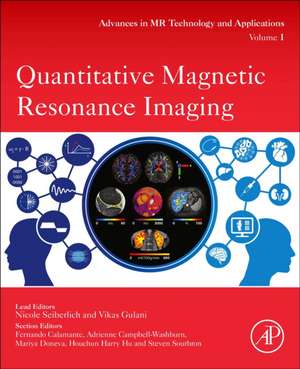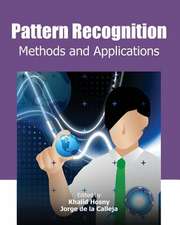Quantitative Magnetic Resonance Imaging: Advances in Magnetic Resonance Technology and Applications, cartea 1
Editat de Nicole Seiberlich, Vikas Gulani, Adrienne Campbell-Washburn, Steven Sourbron, Mariya Ivanova Doneva, Fernando Calamante, Houchun Harry Huen Limba Engleză Paperback – 26 noi 2020
The reader will learn:
- The basic physics behind tissue property mapping
- How to implement basic pulse sequences for the quantitative measurement of tissue properties
- The strengths and limitations to the basic and more rapid methods for mapping the magnetic relaxation properties T1, T2, and T2*
- The pros and cons for different approaches to mapping perfusion
- The methods of Diffusion-weighted imaging and how this approach can be used to generate diffusion tensor
- maps and more complex representations of diffusion
- How flow, magneto-electric tissue property, fat fraction, exchange, elastography, and temperature mapping are performed
- How fast imaging approaches including parallel imaging, compressed sensing, and Magnetic Resonance
- Fingerprinting can be used to accelerate or improve tissue property mapping schemes
- How tissue property mapping is used clinically in different organs
- Structured to cater for MRI researchers and graduate students with a wide variety of backgrounds
- Explains basic methods for quantitatively measuring tissue properties with MRI - including T1, T2, perfusion, diffusion, fat and iron fraction, elastography, flow, susceptibility - enabling the implementation of pulse sequences to perform measurements
- Shows the limitations of the techniques and explains the challenges to the clinical adoption of these traditional methods, presenting the latest research in rapid quantitative imaging which has the possibility to tackle these challenges
- Each section contains a chapter explaining the basics of novel ideas for quantitative mapping, such as compressed sensing and Magnetic Resonance Fingerprinting-based approaches
Preț: 788.80 lei
Preț vechi: 1157.80 lei
-32% Nou
Puncte Express: 1183
Preț estimativ în valută:
150.95€ • 163.91$ • 126.80£
150.95€ • 163.91$ • 126.80£
Carte tipărită la comandă
Livrare economică 16-30 aprilie
Preluare comenzi: 021 569.72.76
Specificații
ISBN-13: 9780128170571
ISBN-10: 0128170573
Pagini: 1092
Dimensiuni: 191 x 235 x 60 mm
Greutate: 1.84 kg
Editura: ELSEVIER SCIENCE
Seria Advances in Magnetic Resonance Technology and Applications
ISBN-10: 0128170573
Pagini: 1092
Dimensiuni: 191 x 235 x 60 mm
Greutate: 1.84 kg
Editura: ELSEVIER SCIENCE
Seria Advances in Magnetic Resonance Technology and Applications
Cuprins
Introduction
SECTION 1 Relaxometry
1. Biophysical and Physiological Principles of T1 and T2
2. Quantitative T1 and T1r Mapping
3. Quantitative T2 and T2* Mapping
4. Multiproperty Mapping Methods
5. Specialized Mapping Methods in the Heart
6. Advances in Signal Processing for Relaxometry
7. Relaxometry: Applications in the Brain
8. Relaxometry: Applications in Musculoskeletal Systems
9. Relaxometry: Applications in the Body
10. Relaxometry: Applications in the Heart
SECTION 2 Perfusion and Permeability
11. Physical and Physiological Principles of Perfusion and Permeability
12. Arterial Spin Labeling MRI: Basic Physics, Pulse Sequences, and Modeling
13. Dynamic Contrast-Enhanced MRI: Basic Physics, Pulse Sequences, and Modeling
14. Dynamic Susceptibility Contrast MRI: Basic Physics, Pulse Sequences, and Modeling
15. Applications of Quantitative Perfusion and Permeability in the Brain
16. Applications of Quantitative Perfusion and Permeability in the Liver
17. Applications of Quantitative Perfusion and Permeability in the Body
SECTION 3 Diffusion
18. Physical and Physiological Principles of Diffusion
19. Acquisition of Diffusion MRI Data
20. Modeling Fiber Orientations Using Diffusion MRI
21. Diffusion MRI Fiber Tractography
22. Measuring Microstructural Features Using Diffusion MRI
23. Diffusion MRI: Applications in the Brain
24. Diffusion MRI: Applications Outside the Brain
SECTION 4 Fat and Iron Quantification
25. Physical and Physiological Properties of Fat
26. Physical and Physiological Properties of Iron
27. Fat Quantification Techniques
28. Applications of Fat Mapping
29. Iron Mapping Techniques and Applications
SECTION 5 Quantification of Other MRI-Accessible Tissue Properties
30. Electrical Properties Mapping
31. Quantitative Susceptibility Mapping
32. Magnetization Transfer
33. Chemical Exchange Mapping
34. MR Thermometry
35. Motion Encoded MRI and Elastography
36. Flow Quantification with MRI
37. Hyperpolarized Magnetic Resonance Spectroscopy and Imaging
SECTION 1 Relaxometry
1. Biophysical and Physiological Principles of T1 and T2
2. Quantitative T1 and T1r Mapping
3. Quantitative T2 and T2* Mapping
4. Multiproperty Mapping Methods
5. Specialized Mapping Methods in the Heart
6. Advances in Signal Processing for Relaxometry
7. Relaxometry: Applications in the Brain
8. Relaxometry: Applications in Musculoskeletal Systems
9. Relaxometry: Applications in the Body
10. Relaxometry: Applications in the Heart
SECTION 2 Perfusion and Permeability
11. Physical and Physiological Principles of Perfusion and Permeability
12. Arterial Spin Labeling MRI: Basic Physics, Pulse Sequences, and Modeling
13. Dynamic Contrast-Enhanced MRI: Basic Physics, Pulse Sequences, and Modeling
14. Dynamic Susceptibility Contrast MRI: Basic Physics, Pulse Sequences, and Modeling
15. Applications of Quantitative Perfusion and Permeability in the Brain
16. Applications of Quantitative Perfusion and Permeability in the Liver
17. Applications of Quantitative Perfusion and Permeability in the Body
SECTION 3 Diffusion
18. Physical and Physiological Principles of Diffusion
19. Acquisition of Diffusion MRI Data
20. Modeling Fiber Orientations Using Diffusion MRI
21. Diffusion MRI Fiber Tractography
22. Measuring Microstructural Features Using Diffusion MRI
23. Diffusion MRI: Applications in the Brain
24. Diffusion MRI: Applications Outside the Brain
SECTION 4 Fat and Iron Quantification
25. Physical and Physiological Properties of Fat
26. Physical and Physiological Properties of Iron
27. Fat Quantification Techniques
28. Applications of Fat Mapping
29. Iron Mapping Techniques and Applications
SECTION 5 Quantification of Other MRI-Accessible Tissue Properties
30. Electrical Properties Mapping
31. Quantitative Susceptibility Mapping
32. Magnetization Transfer
33. Chemical Exchange Mapping
34. MR Thermometry
35. Motion Encoded MRI and Elastography
36. Flow Quantification with MRI
37. Hyperpolarized Magnetic Resonance Spectroscopy and Imaging








































